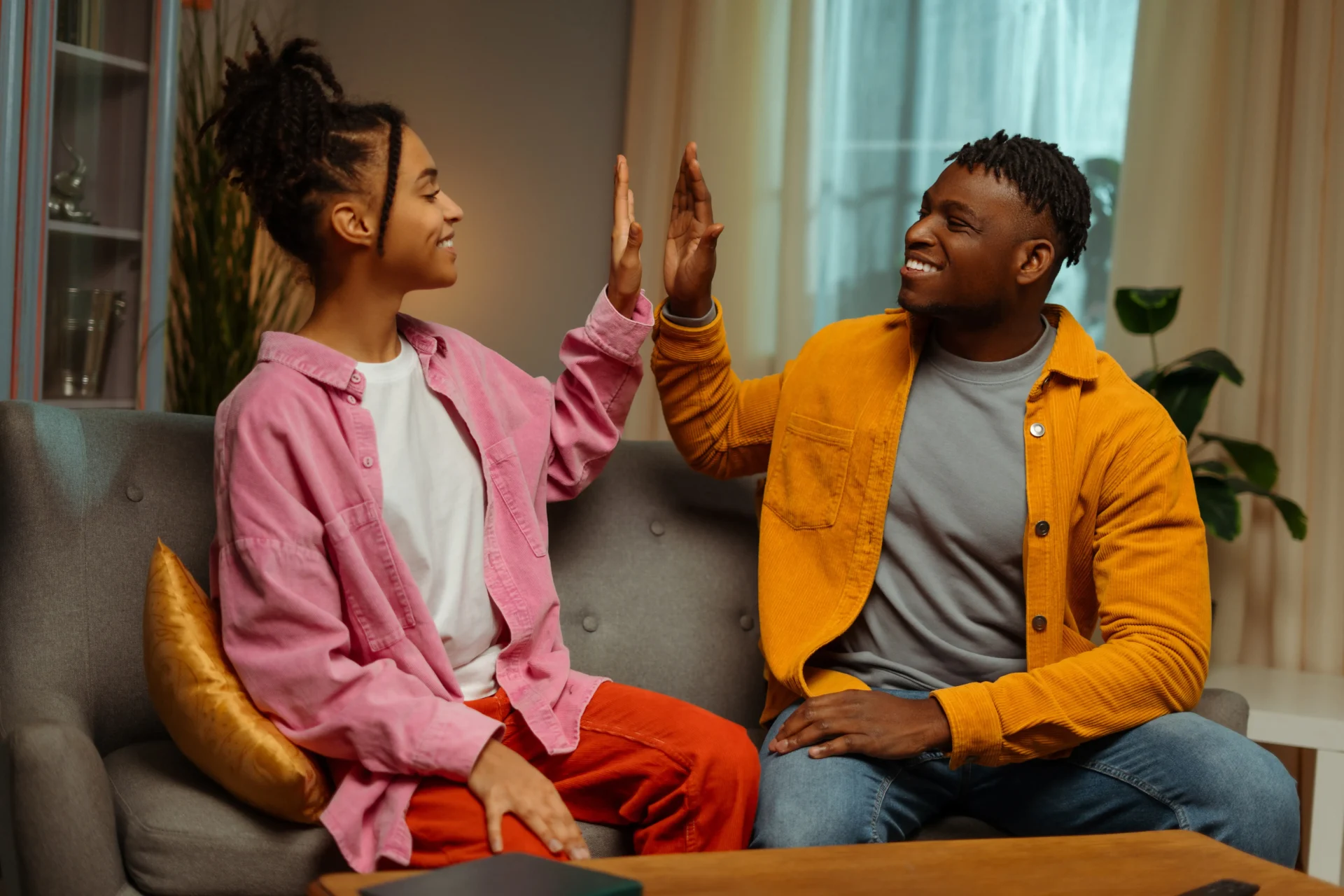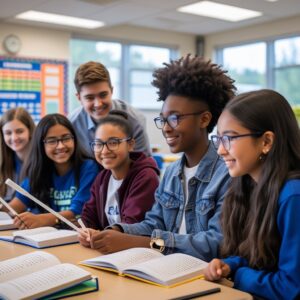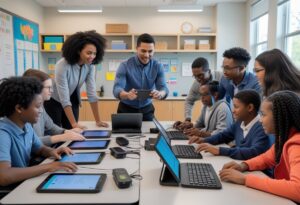Mastering Nonverbal Communication for Deaf-Blind Individuals

Essential Techniques and Insights
Nonverbal communication techniques for deaf-blind individuals are essential in fostering understanding and connection when traditional verbal methods are not an option. At New England Low Vision and Blindness, we recognize the transformative impact of innovative communication strategies. By mastering nonverbal communication techniques, deaf-blind individuals can enhance their ability to interact effectively, promoting inclusivity and personal empowerment in their daily lives.
Through touch, gestures, and innovative technology, nonverbal communication can provide a richer, more nuanced understanding of the world. For individuals who are deaf-blind, embracing these methods opens the door to more independent living and meaningful social interactions. We are committed to supporting this journey with our life-changing resources and training.
Our dedication to promoting effective communication strategies stems from our belief that everyone deserves a voice. By championing these techniques, we strive to bring hope to those navigating the challenges of sensory impairments, ensuring they are fully included and valued in all aspects of life.
Discover NuCaption: Real-Time Solutions for the Deaf-Blind Community
 Empower communication with NuCaption, the innovative tool designed specifically for the Deaf-Blind community. This real-time captioning solution transforms the way individuals interact with the world, providing clear, accessible, and immediate text translation during conversations. Whether you’re at a meeting, in class, or enjoying social events, NuCaption bridges the gap and fosters inclusive environments.
Empower communication with NuCaption, the innovative tool designed specifically for the Deaf-Blind community. This real-time captioning solution transforms the way individuals interact with the world, providing clear, accessible, and immediate text translation during conversations. Whether you’re at a meeting, in class, or enjoying social events, NuCaption bridges the gap and fosters inclusive environments.
Learn more and explore how NuCaption can transform your experience today. Visit our product page NuCaption – Real-Time Solutions for the Deaf-Blind Community or watch our video.
Understanding Deafblindness and Communication Challenges
Deafblindness presents unique communication challenges. Developing effective non-verbal communication strategies is essential for making meaningful connections and enhancing daily interactions.
The Spectrum of Deafblindness
Deafblindness is a condition where an individual has both hearing and visual impairments. This condition varies widely. Some people might have partial hearing and vision, while others could have complete loss in both senses. Recognizing this spectrum is crucial because communication needs and strategies differ significantly based on each person’s specific impairments.
Utilizing various senses and remaining attentive to personal preferences can greatly facilitate communication. Many deafblind individuals rely on tactile methods, like sign language used in direct physical contact or tactile symbols, to exchange information. It’s vital to assess the unique combination of sensory impairments to determine the best communication methods.
Key Communication Barriers
Communication barriers for those with deafblindness can be profound. The dual impairment restricts the use of traditional auditory or visual signals. This necessitates alternative techniques, such as specialized sign languages, Braille, and non-verbal cues like touch cues or tracking. These methods help bridge the communication gap in effective ways.
Each deafblind individual faces unique challenges. Limited access to real-time auditory or visual feedback can hinder their ability to engage in conversations or respond promptly. Our goal is to provide leading-edge assistive technologies to empower individuals by adapting to their specific communication requirements. It’s this personalized approach that helps us offer hope and tangible solutions for their unique communication needs.
Nonverbal Communication Techniques
Nonverbal communication is a vital aspect for deaf-blind individuals to receive and express information. Mastery of techniques such as facial expressions, body language, gestures, and non-verbal cues can greatly enhance interactions and understanding.
Facial Expressions and Body Language
Understanding facial expressions and body language plays a crucial role in communication for deaf-blind individuals. Although facial expressions might seem less relevant due to visual impairment, the tactile sense can help bridge this gap. For instance, physical touch on the face can convey emotions such as happiness or sadness through slight changes in facial tension.
Body language is equally essential. By understanding posture or orientation of the body, one can perceive levels of engagement or attention. An upright stance and forward orientation suggest attentiveness, while a relaxed posture might indicate comfort or relaxation. Using these tactile cues can effectively communicate emotion and intent.
Use of Gestures and Touch
Gestures and touch are primary communication methods for those who are deaf-blind. Tactile sign language is a significant tool, where gestures of one’s hands are felt by another person to interpret language. This method is vital as it allows for a tactile connection between the communicator and receiver.
Touch can also convey complex emotions or instructions. For instance, a pat on the back can signal approval or encouragement. Hand-over-hand guidance can be used for directional cues or to express a shared activity. By employing a combination of gestures and meaningful touch, we can ensure effective and nuanced communication.
Employing Non-Verbal Cues
Non-verbal cues expand communication beyond gestures and touch. These cues can include vibrations, temperature changes, or the use of assistive technology like vibrating devices for notifications. Environmental cues, such as changes in room temperature or airflow, can provide contextual information about the surroundings.
Additionally, maintaining consistent communication routines can help in recognition of non-verbal cues. Consistent routines enable deaf-blind individuals to anticipate and recognize the intended message behind a cue. In using these tools, we aim to create an enriched communication environment that supports and empowers the individual’s independence.
Adaptive Communication Methods
Communication for deaf-blind individuals involves unique approaches. Methods like sign language adaptations, braille, and assistive devices are pivotal. Here’s how they can be utilized to enhance interaction.
Sign Language Varieties
For those who are deaf-blind, traditional sign language requires adaptation. Tactile signing allows communication by forming signs in their hands. This method respects the space and feedback needed by the tactile communication process.
Another method includes the Keyword Sign, which involves using fewer signs focusing on essential concepts. Our leading-edge tools offer opportunities to learn these personalized approaches, fostering richer interaction.
Braille and the Deafblind Manual Alphabet
Braille is a crucial literacy tool, enabling reading and writing through tactile feedback. Combining it with the Deafblind Manual Alphabet allows spelling out words letter by letter, offering a personalized method of communication.
This combination provides flexibility in sharing personal or unique information. Our commitment at New England Low Vision and Blindness is to empower each person with appropriate training and resources, ensuring their communication needs are met effectively.
Assistive Communication Devices
Our comprehensive range of assistive devices bridges communication gaps for individuals with dual sensory impairments. Devices such as electronic braille displays and screen readers are instrumental in enhancing interaction.
These assistive communication devices offer real-time text conversion and voice output, making communication more accessible and inclusive. We continually strive to provide innovative and supportive technology solutions, enabling greater independence for those we serve.
Interactive Strategies and Inclusive Practices
Our approach focuses on creating environments that foster inclusivity and improve interaction techniques for deaf-blind individuals. We emphasize empathy and active feedback to ensure a rich communicative experience for everyone involved.
Creating an Inclusive Environment
To construct an inclusive environment, it’s essential to incorporate tools that cater to the needs of deaf-blind individuals. This involves tactile communication methods, such as Braille and tangible sign language. Utilizing leading-edge technologies, like tactile signing devices and refreshable Braille displays, can significantly enhance communication.
Adjusting the physical space to accommodate these devices ensures greater access and participation. Moreover, training sessions for both the individuals and their peers can facilitate better understanding and collaborative interactions in various settings.
Engagement and Feedback Techniques
Engagement is pivotal for effective communication with deaf-blind individuals. We prioritize interactive sessions that allow for continuous feedback. One technique is to employ tactile sign language paired with real-time feedback through touch-based systems.
Another effective method is the use of communication boards that are both tactile and visually distinct. Encouraging direct physical responses during interactions helps refine techniques and ensures clarity. We support ongoing dialogue to continually adapt and improve these strategies as needed.
Building Empathy and Understanding
Empathy plays a critical role in fostering effective communication with deaf-blind individuals. We believe that building this understanding starts with awareness training for those who work and interact with these individuals. A key aspect is recognizing the unique challenges faced and communicating in ways that respect their experiences.
Encouraging shared experiences through role-playing scenarios can increase empathy and comprehension amongst all parties. By prioritizing these personalized interactions, we work towards not only improving communication but also building a community that truly embraces and supports the needs of deaf-blind individuals.
Enhancing Communication Through Technology and Education
We explore two vital areas: the role of educational resources in cultivating communication skills and recent technological advancements that support individuals with deaf-blindness. Both dimensions are crucial for bridging communication gaps and fostering independence.
Educational Resources for Communication Skills
Educational resources are essential in teaching effective communication skills to individuals who are deaf-blind. These resources often include tactile sign languages such as American Sign Language (ASL) and British Sign Language (BSL), which are adapted for touch, allowing users to communicate effectively. Makaton is another system that combines signs and symbols for simpler communication, especially useful in educational settings.
Training services play a significant role. Programs that focus on orientation and mobility, communication skills, and independent living contribute to boosting confidence and autonomy. By building a strong foundation in these skills, individuals gain the ability to navigate their environments more freely. As we provide tailored training, we help empower individuals with the tools necessary for a fulfilling life.
Technological Aids and Innovations
The integration of technology significantly advances the communication abilities of those who are deaf-blind. Innovative tools and devices such as hearing aids, refreshable braille displays, and speech-generating devices facilitate interaction by converting text and speech into accessible formats.
Leading-edge solutions, like video relay services, enable real-time communication with interpreters using pictures or text. Technologies like these bridge sensory gaps, allowing for more seamless interaction across varying platforms.
We focus on developing and providing these assistive technologies to enhance accessibility. Our goal is to bring hope and independence to individuals by offering solutions that cater specifically to their needs, broadening their communication possibilities.
Frequently Asked Questions
We are committed to supporting the deaf-blind community by providing essential communication tools and methods. Here, we address common inquiries about communication techniques and technologies that enhance interaction for deaf-blind individuals.
What techniques are employed to facilitate communication with deaf-blind individuals?
Deaf-blind individuals use a variety of methods tailored to their needs, such as sign language adapted to tactile forms, tactile fingerspelling, and communication cards. We focus on adapting each technique to suit personal preferences and abilities.
How are tactile sign language and other touch-based methods utilized in deaf-blind communication?
Tactile sign language involves signing into a person’s hand, enabling them to feel the movement and shape of signs. Other techniques include tadoma and print on palm methods to convey messages through touch.
Which technologies are considered most effective for aiding communication among the deaf-blind community?
Leading-edge technologies, such as Braille displays and portable note-takers, play a crucial role. These technologies are designed to assist with reading and writing, improving access to information for those with combined vision and hearing loss.
What are the foundational steps in teaching language and communication skills to deaf-blind children?
Early intervention is vital, beginning with basic communication methods like object cues and hand-under-hand signing to build a foundation. Our approach focuses on developing personalized strategies that teach language in an interactive, supportive environment.
In what ways can one convey complex concepts and abstract ideas to someone who is deaf-blind?
We employ a gradual approach, using concrete examples linked to experiences before introducing abstract ideas. This method can involve multisensory input, assisting in making complex concepts more comprehensible.
How are communication strategies adapted for deaf-blind adults who have acquired deaf-blindness later in life?
For adults acquiring deaf-blindness, we tailor strategies to leverage their existing communication skills. This may include modifying known methods and introducing new techniques gradually, ensuring comfort and effectiveness in daily interactions.
Experience Empowerment with Our Deaf-Blind Training
Unlock independence and enhance accessibility with our specialized Deaf-Blind Training services. Whether you’re an individual seeking tailored solutions, an organization striving to create inclusive environments, or a caregiver aiming to support loved ones, our training is designed to provide practical tools and strategies.
Learn More & Get Started Today
Discover NuCaption: Real-Time Solutions for the Deaf-Blind Community
 Empower communication with NuCaption, the innovative tool designed specifically for the Deaf-Blind community. This real-time captioning solution transforms the way individuals interact with the world, providing clear, accessible, and immediate text translation during conversations. Whether you’re at a meeting, in class, or enjoying social events, NuCaption bridges the gap and fosters inclusive environments.
Empower communication with NuCaption, the innovative tool designed specifically for the Deaf-Blind community. This real-time captioning solution transforms the way individuals interact with the world, providing clear, accessible, and immediate text translation during conversations. Whether you’re at a meeting, in class, or enjoying social events, NuCaption bridges the gap and fosters inclusive environments.
Learn more and explore how NuCaption can transform your experience today. Visit our product page NuCaption – Real-Time Solutions for the Deaf-Blind Community or watch our video.



